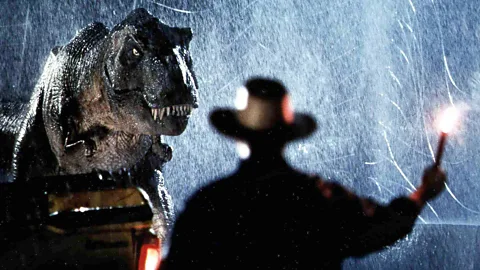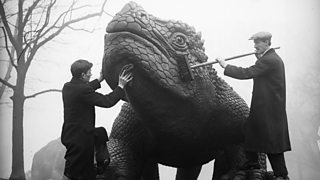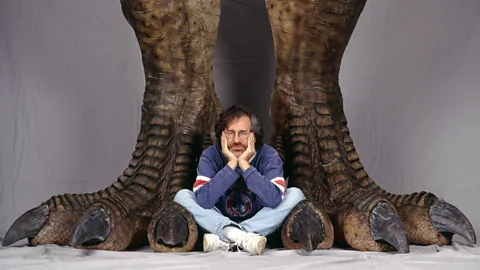‘They’ve become extinct, and are we next?’: How Jurassic Park made dinosaurs into film stars
2 days agoShareSave
Francis Agustin

In June 1993, Steven Spielberg’s adaptation of Michael Crichton’s novel brought prehistoric monsters to life. Crichton spoke to the BBC about why dinosaurs continue to fascinate us.
One of the most celebrated moments in Steven Spielberg’s Jurassic Park has two scientists, played by Sam Neill and Laura Dern, staring agasp at a Brachiosaurus towering above them – it’s the first time these characters and the audience have glimpsed the colossus in all its onscreen glory. As John Williams’s iconic overture swells, a wave of childlike wonder washes over their faces. And ever since the film premiered 32 years ago, on 9 June 1993, audiences have felt a similar awe. The franchise now includes animated television series, comics, video games, and seven major films, including the latest instalment, Jurassic World Rebirth, which is released in July. But it all started with Michael Crichton’s bestselling novel, published in 1990.
While writing the novel, Crichton visited a museum in the UK which featured a video exhibit on dinosaurs. “Little boys and girls of three [years old] would scream ‘Stegosaurus!’ and ‘Tyrannosaurus!’ when they would appear,” Crichton told the BBC’s The Late Show in 1993. “You wouldn’t think they’d know how to pronounce these words, but they do.”

1:51’Our question when we look at dinosaurs is, they’ve become extinct, and are we next?’
Since the discovery of the first dinosaur fossils two centuries ago, and the first official scientific naming of a dinosaur – the Megalosaurus – in 1824, our fascination with these titans of the natural world has never really waned. But it has evolved. “We have in every period some [new] aspect of interest, not so much in our own reinterpretation of the dinosaurs from a scientific standpoint, but from a cultural standpoint,” said Crichton.
In 1854, a number of supposedly life-sized model dinosaurs, sculpted by Benjamin Waterhouse Hawkins and cast in cement, were displayed in Crystal Palace Park in south London. At this point, Crichton believed, “the underlying issue soon became whether these were evidence that ought to be employed for or against Darwinian evolution, so after the initial interest in dinosaurs as simply large extinct animals, they came to be viewed from the standpoint of their religious significance.”

By the time Crichton wrote Jurassic Park, however, our view of dinosaurs had moved on, both scientifically and philosophically. The podgy beasts sculpted by Hawkins had been replaced in the imagination by fast, agile, birdlike creatures – and the issue of the dinosaurs’ extinction was considered of greater philosophical interest than their creation. “The question that we have when we look at dinosaurs is, ‘They’ve become extinct, and are we next,'” Crichton said.
In History
In History is a series which uses the BBC’s unique audio and video archive to explore historical events that still resonate today. Sign up to the accompanying weekly newsletter.
In between these two periods, dinosaurs stomped through cinema history. The first onscreen dinosaur starred in an animated film, Gertie the Dinosaur, in 1914. A classic silent film, The Lost World (1925), boasted stop-motion dinosaurs created by Willis O’Brien, who went on to animate the prehistoric monsters who fought King Kong in 1933. The dinosaurs in King Kong then inspired legendary animator Ray Harryhausen to create his own unique dinosaur hybrid for the film 20,000 Fathoms (1953), a Tyrannosaurus-Brontosaurus mix that rampaged through the streets of New York City. Harryhausen would go on to direct his own prehistoric monster film, One Million Years B.C. (1966), in which Raquel Welch and other fur-clad cave-people came face-to-face with dinosaurs. “We were criticised many times that human beings, particularly cavemen… never lived anywhere near the time of the dinosaur,” Harryhausen said on The Late Show. “But that’s a licence one has to take for the cinema because you have no drama unless you have people in with the dinosaurs.”
Breaking box-office records
The film of Jurassic Park, with a screenplay co-written by Crichton, brought together people and dinosaurs more believably than ever before. Spielberg used a groundbreaking and earth-shaking combination of computer-generated imagery and practical animatronics for his cautionary tale of a corporation miraculously resurrecting long-extinct species. The corporation’s CEO, John Hammond (Richard Attenborough), intends to use the creatures to populate a wildlife amusement park on an island off the coast of Costa Rica. But when the dinosaurs escape their enclosures, a group of scientists learn the hard way that Hammond’s plan may have its drawbacks.
The film was a blockbuster hit in the summer of 1993, grossing $357 million domestically and $914 million worldwide in its original theatrical run. It shattered box office records, becoming the highest grossing film ever at the time of its release. Jurassic Park “delivers where it counts, in excitement, suspense and the stupendous realization of giant prehistoric reptiles”, said Variety’s 1993 review. In 2018, it was added to the Library of Congress’s National Film Registry for being “culturally, historically, or aesthetically significant”.
More like this:
• How a child star saved a Hollywood star from bankruptcy
• The film that made Arnold Schwarzenegger a superstar
• Hitchcock reveals the secret to his masterpieces
None of the sequels or spin-offs has been quite so significant, but all of the films have been Brachiosaurus-sized hits. Spielberg directed The Lost World: Jurassic Park (1997), and then Joe Johnston took the reins for Jurassic Park III (2001). That film appeared to be the end of the big-screen series, but eventually Jurassic World (2015) roared into cinemas, beginning another trilogy: at the time, it was the third highest-grossing film ever released.
Dinosaurs still instil childlike wonder, it seems, and as long as they do, the Jurassic Park franchise won’t remain extinct for long.
—
For more stories and never-before-published radio scripts to your inbox, sign up to the In History newsletter, while The Essential List delivers a handpicked selection of features and insights twice a week.
For more Culture stories from the BBC, follow us on Facebook, X and Instagram.


